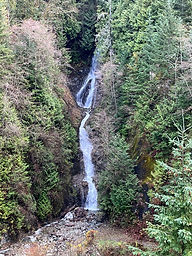Turn off the Lights, Turn on the Night
- Bird Friendly Lions Bay

- 12 hours ago
- 3 min read
Ways you can support night-migrating birds

by Penny Nelson, founder/team lead Bird Friendly Lions Bay
Although Lions Bay is on the Pacific Flyway, a major migratory route for birds, we don’t often see large numbers of birds flying by.
This is because around 80% of bird species, especially small birds, undertake these gruelling journeys at night to take advantage of calmer air, avoid daytime predators and use the stars for navigation.
Studies estimate light pollution is increasing by 10% a year and the growing presence of artificial light can disorient migrating birds, leading to collisions and other often fatal dangers. When confused and off course, they use precious energy trying to find their way, becoming vulnerable to predators and exhaustion.
About half of all insects are nocturnal and are also harmed by light at night. Dwindling insect populations lead to reduced food sources for birds, especially important during the twice-yearly migrations.
In a recent presentation to Bird Teams across Canada, Roland Dechesne, a fellow and committee member of the Royal Astronomical Society of Canada and Bird Friendly Calgary team member, outlined the effects of artificial light on migratory birds and humans.
He referred to a 2009 declaration by the American Medical Association (AMA) in support of efforts to reduce light pollution and advocating for non-glare lighting. The AMA cited studies on the disruption of human and animal circadian rhythms and increases in certain cancer types as cause for serious concern.
He also highlighted a less commonly known impact of artificial light on migratory birds, the early and late triggering of migratory restlessness. This is usually prompted by the lengths of days and nights. Artificially lit nights in southern wintering areas trigger spring migration too early leading to a mismatch in food sources along migration routes and, on arrival, in summer breeding areas. In the fall, delays caused by light at night could mean birds linger in the Northern Hemisphere for too long before heading south.
How You Can Help
In a world where we often feel helpless about human impacts on wildlife, it’s encouraging to know we can each do something to make a difference. Here’s how:
Direct all outdoor lighting downward. Position lights to light the floor or ground and use shields to prevent light shining into the sky.
Turn off lights by 10 p.m. during bird migration seasons (April–May and August–November). It is best to take these measures as early in the evening as possible, because birds begin their migrations at dusk.
Reduce the amount of light outside your home or business. Turn off non-essential lights and use timers or motion detectors for essential lights. Always use the minimum wattage necessary for the task at hand.
Change the colour of your lights from cool to warm. Use light bulbs that emit warm light colours to minimize disturbance to birds (less than 3,000 kilowatts).
Share the message to “dim the lights for birds at night.” Speak to family and friends and share these messages to increase awareness of this important issue.
Click HERE to learn more easy ways to protect our birds. You can also join Bird Friendly Lions Bay on Facebook.
The Watershed values your opinion.
Leave a comment below,
or email editor@lionsbaywatershed.ca
Like what you're reading?
For as little as $5/month, you can support local independent journalism
by subscribing to The Watershed HERE.








Wow, migrating long distances at night? I had no idea!
Sometimes I find it difficult just getting home in the dark along the Sea-to-Sky during bad weather, so my appreciation for these small avian migrants increased after reading this!
Equipped with these facts, hope my human neighbours will turn off their lights at night!